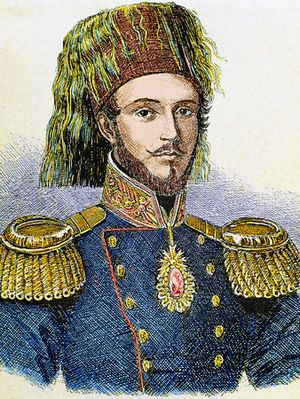Abdulmejid I facts for kids
Quick facts for kids Abdulmejid I |
|||||
|---|---|---|---|---|---|
| Ottoman Caliph Amir al-Mu'minin Custodian of the Two Holy Mosques Khan |
|||||
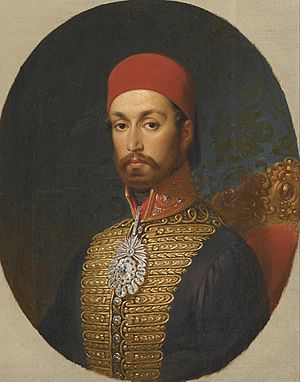
Portrait by Konstantin Cretius
|
|||||
| Sultan of the Ottoman Empire (Padishah) | |||||
| Reign | 2 July 1839 – 25 June 1861 | ||||
| Predecessor | Mahmud II | ||||
| Successor | Abdulaziz | ||||
| Grand Viziers |
See list
Husrev Pasha
Sadık Rıfat Pasha Mehmed Emin Rauf Pasha Ibrahim Sarim Pasha Topal Izzet Mehmed Pasha Mustafa Reşid Pasha Mehmed Emin Âli Pasha Damat Mehmed Ali Pasha Mustafa Naili Pasha Kıbrıslı Mehmed Emin Pasha Mehmed Rushdi Pasha |
||||
| Born | 25 April 1823 Constantinople, Ottoman Empire |
||||
| Died | 25 June 1861 (aged 38) Constantinople, Ottoman Empire |
||||
| Burial | Yavuz Selim Mosque, Fatih, Istanbul | ||||
| Consorts | See below | ||||
| Issue Among others |
See
|
||||
|
|||||
| Dynasty | Ottoman | ||||
| Father | Mahmud II | ||||
| Mother | Bezmiâlem Sultan | ||||
| Religion | Sunni Islam | ||||
| Tughra |  |
||||
Abdulmejid I (born 25 April 1823, died 25 June 1861) was the 31st Sultan of the Ottoman Empire. He became Sultan on 2 July 1839, taking over from his father, Mahmud II.
His time as Sultan was important because of the rise of nationalist feelings in different parts of the empire. Abdulmejid wanted to unite everyone under the idea of "Ottomanism." He hoped new laws and changes would help non-Muslims and non-Turks feel more included. However, these efforts did not stop the growing nationalist movements.
Abdulmejid also worked to make friends with powerful countries in Western Europe, like the United Kingdom and France. These countries even fought alongside the Ottoman Empire in the Crimean War against Russia. After the war, at the Congress of Paris in 1856, the Ottoman Empire was officially welcomed into the group of European nations.
His greatest achievement was starting and carrying out the Tanzimat reforms. These "reorganization" reforms were planned by his father and began the modernization of the Ottoman Empire in 1839. Because of this, one of the imperial anthems of the Ottoman Empire, the March of Abdulmejid, was named after him.
Contents
Early Life and Education
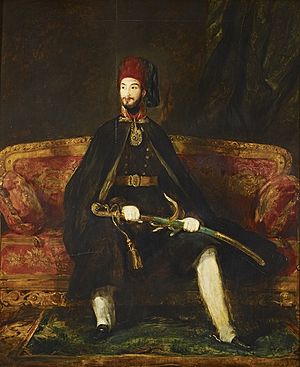
Abdulmejid was born on 25 April 1823, either at the Beşiktaş Palace or the Topkapı Palace in Istanbul. His mother was Valide sultan Bezmiâlem, who became his father's first wife in 1839. She was originally named Suzi and was either from Circassia or Georgia.
Abdulmejid received a European-style education. He was the first Sultan to speak French fluently. Like his son Abdülaziz, who became Sultan after him, Abdulmejid loved literature and classical music. He was also a strong supporter of reforms, just like his father Mahmud II. He was lucky to have smart and forward-thinking advisors, such as Mustafa Reşit Pasha.
Abdulmejid was also the first Sultan to directly listen to people's complaints. He held special meetings, usually every Friday, where ordinary people could speak to him without needing anyone in between. He also traveled around the empire to see for himself how the Tanzimat reforms were working. For example, he visited places like İzmit, Bursa, and Gallipoli in 1844, and toured the Balkan areas in 1846.
Becoming Sultan and Early Challenges
Abdulmejid became Sultan on 2 July 1839, when he was only sixteen years old. The Ottoman Empire was in a very difficult situation at that time. Just as his father died, news arrived that the empire's army had been defeated. This happened at the Battle of Nezib by the army of Muhammad Ali, the ruler of Egypt.
At the same time, the Ottoman navy sailed to Alexandria and was handed over to Muhammad Ali by its commander. This made the situation even worse. However, European countries stepped in during the Oriental Crisis of 1840. They helped settle the conflict, and Muhammad Ali had to agree to terms. This saved the Ottoman Empire from more attacks and returned its lands in Syria, Lebanon, and Palestine. The final agreement was made at the Convention of London (1840).
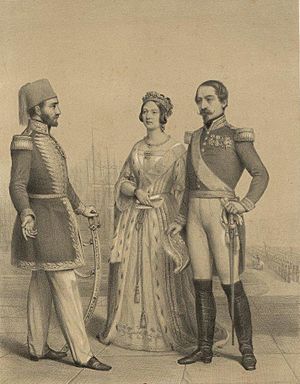

In 1846, the Egyptian governor Mehmed Ali Pasha visited Istanbul. Sultan Abdulmejid and his government welcomed him with great honor. To make travel easier, the Galata bridge was built in 1845, connecting the Beșiktaș Palace to the government offices.
Important Reforms and Changes
Following his father's wishes, Abdulmejid immediately started the reforms. In November 1839, he announced an important law called the Hatt-ı Șerif of Gülhane, also known as Tanzimat Fermanı. This law officially began and strengthened the reforms. Another similar law, the Ottoman Reform Edict of 1856 (Islâhat Hatt-ı Hümâyûnu), was issued in 1856 after the Crimean War.
These laws promised that everyone in the empire, no matter their background, would have their lives and property protected. Taxes would be fair, and justice would be given to everyone equally. All people would have full religious freedom and equal civil rights. These changes faced strong opposition from some Muslim leaders and religious authorities. Because of this, the reforms were only partly put into action, especially in far-off parts of the empire. Some people even plotted against the Sultan because of these changes.
Key Reforms by Abdulmejid
Among the many changes Abdulmejid brought were:
- The first Ottoman paper banknotes were introduced in 1840.
- The army was reorganized, and conscription (mandatory military service) was started between 1842 and 1844.
- An Ottoman national anthem and Ottoman national flag were adopted in 1844.
- The financial system was reorganized, based on the French model.
- Civil and Criminal laws were reorganized, also following the French model.
- The court system was changed, creating civil and criminal courts with both European and Ottoman judges.
- The Meclis-i Maarif-i Umumiye was set up in 1845. This was a first step towards the Ottoman Parliament that would be formed later in 1876.
- A council for public education was created in 1846.
- A Ministry of Education was established.
- There were plans to send money to Ireland during its Great Famine. The Sultan wanted to send £10,000, but later agreed to send £1,000. This was done to avoid giving more than Queen Victoria of Britain, who had donated £2,000.
- Plans were made to end slave markets in 1847.
- Modern universities and academies were established in 1848.
- An Ottoman school was opened in Paris.
- A special tax on non-Muslims was removed in 1856.
- Non-Muslims were allowed to join the Ottoman army starting in 1856.
- New land laws were introduced in 1858, confirming the right to own property.
Another important change was that the turban was officially banned during Abdulmejid's rule. Instead, people were encouraged to wear the fez. European clothing styles also became popular at the royal court.
Abdulmejid was known for being kind and honorable. He refused to hand over Kossuth and others who sought refuge in Turkey after a Hungarian uprising in 1849, even when Austria and Russia demanded it. He also did not allow people who plotted against him to be put to death.
In 1844, he created the Ottoman lira currency. In 1851, he started the Order of the Medjidie award.
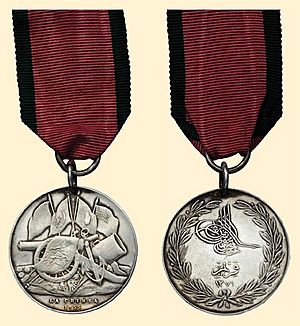
The Ottoman Empire took its first foreign loans starting in 1854 during the Crimean War. More loans followed, which eventually led to financial problems.
Abdulmejid also made many improvements to buildings. Between 1847 and 1849, he had the Hagia Sophia mosque repaired. He was also responsible for building the Dolmabahçe Palace, which was the first European-style palace in Istanbul. He also opened the first French Theatre in Istanbul. Other important buildings from his time include the Beykoz Pavilion (1855) and the Küçüksu Pavilion (1857).
Death
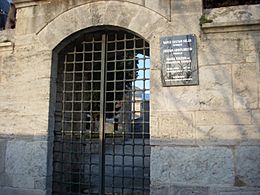
Abdulmejid died from tuberculosis (a lung disease) on 25 June 1861, at the age of 38, in Istanbul. He was buried in the Yavuz Selim Mosque. His younger half-brother, Sultan Abdülaziz, became the next ruler.
Family
Abdulmejid I had many wives and children. He was the first Sultan whose wives were not mainly enslaved women, but rather women of free birth, often from noble or wealthy families. This was because slavery was slowly being ended in the Ottoman Empire.
Notable Children
Abdulmejid I had several sons and daughters who became important figures in Ottoman history:
- Murad V (1840-1904) - He became the 33rd Sultan of the Ottoman Empire.
- Abdülhamid II (1842-1918) - He became the 34th Sultan of the Ottoman Empire.
- Mehmed V Reşad (1844-1918) - He became the 35th Sultan of the Ottoman Empire.
- Mehmed VI Vahideddin (1861-1926) - He became the 36th and last Sultan of the Ottoman Empire.
- Fatma Sultan (1840-1884)
- Refia Sultan (1842-1880)
- Cemile Sultan (1843-1915)
- Münire Sultan (1844-1862)
- Behice Sultan (1848-1876)
- Seniha Sultan (1851-1931)
- Mediha Sultan (1856-1928)
- Naile Sultan (1856-1882)
Honours
 1851: He founded the Order of the Medjidie, an Ottoman award.
1851: He founded the Order of the Medjidie, an Ottoman award. 1856: He received the Grand Cross of the Tower and Sword from Portugal.
1856: He received the Grand Cross of the Tower and Sword from Portugal. 1856: He was made a Stranger Knight of the Garter by the United Kingdom.
1856: He was made a Stranger Knight of the Garter by the United Kingdom. 1860: He received the Grand Cordon of the Order of Leopold from Belgium.
1860: He received the Grand Cordon of the Order of Leopold from Belgium. He received the Grand Cross of the Legion of Honour from France.
He received the Grand Cross of the Legion of Honour from France.
In Fiction
- A made-up version of Abdulmejid I appears in the 2008 book The Bellini Card, written by Jason Goodwin.
See also
 In Spanish: Abdülmecit I para niños
In Spanish: Abdülmecit I para niños


